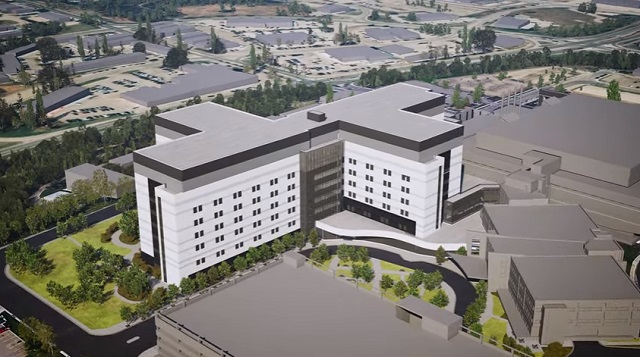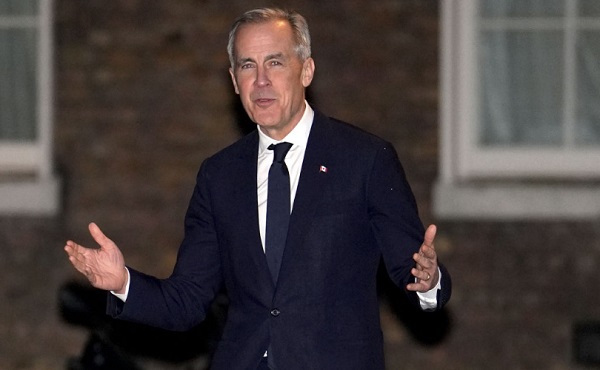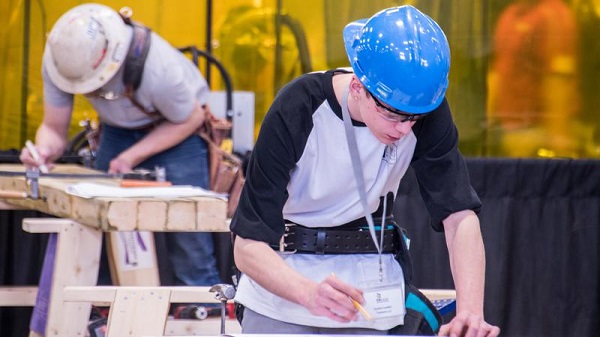Alberta
Clark Builders awarded construction manager contract to build patient tower, expand and renovate Red Deer Regional Hospital

Site preparation work is underway now that a construction contract has been awarded for the Red Deer Regional Hospital Centre redevelopment project.
The redevelopment of the Red Deer Regional Hospital Centre has been a priority infrastructure project since 2019. Over the last five years, significant work has been undertaken, including the development of the business case, extensive planning and coordination with multiple partners, public consultation, design and early site preparation. Following a competitive procurement process, Clark Builders has been awarded the construction manager contract to build the new patient tower and expand and renovate the existing hospital building in Red Deer.
Clark Builders will complete early site preparations such as demolishing the existing Annex building and surface parking lot. By early 2025, construction will begin on the new patient tower. Renovations will also begin in specific locations of the existing facility, with a focus on minimizing any disruption to hospital operations.
“This construction contract award is a significant milestone in moving the Red Deer Hospital project forward. To this point, all the work – planning, design, and procurement – propelling the project forward has been behind the scenes. Now, everyone will see the physical work as contractors set up offices, equipment, fencing and signage on site. I am excited to see progress on this project and for the people of Red Deer.”
Alberta’s government is committed to ensuring residents of the Red Deer region can access the care they need, when and where they need it. This project will not only expand and modernize the space, it will provide significant upgrades to services throughout the hospital, such as adding add 200 inpatient beds, increasing the size of the emergency room and adding six new operating rooms. Additionally, the redevelopment will add a new Medical Device Reprocessing department, new cardiac catheterization labs and a new centralized power plant.
“The Red Deer Regional Hospital redevelopment project is a priority for our government. We recognize there is an urgent need to increase capacity and expand services in central Alberta, and the awarding of this contract signifies progress being made towards ensuring patients can receive the health care they deserve close to home.”
“I am pleased to see this vital project advancing with the awarding of the construction manager contract to Clark Builders. This is good news for Red Deer and improving access to healthcare. With site preparations underway and visible construction on the new patient tower beginning soon, there is a strong future ahead for our city!”
A new ambulatory building will also be constructed as part of the Red Deer Regional Hospital Centre redevelopment, but as a stand-alone project to be delivered using a public-private partnership delivery method. A contract with the successful organization is expected to be in place by May 2025 and construction will begin shortly thereafter.
Quick facts
- Over the next three years, Alberta’s 2024 Capital Plan is providing $810 million toward a $1.806-billion investment for redevelopment of the Red Deer Regional Hospital Centre.
- Initial site preparation is currently underway with a separate construction management team (Shunda Consulting and Construction Management) that was engaged in June 2024 to complete early construction activities.
Alberta
Big win for Alberta and Canada: Statement from Premier Smith

Premier Danielle Smith issued the following statement on the April 2, 2025 U.S. tariff announcement:
“Today was an important win for Canada and Alberta, as it appears the United States has decided to uphold the majority of the free trade agreement (CUSMA) between our two nations. It also appears this will continue to be the case until after the Canadian federal election has concluded and the newly elected Canadian government is able to renegotiate CUSMA with the U.S. administration.
“This is precisely what I have been advocating for from the U.S. administration for months.
“It means that the majority of goods sold into the United States from Canada will have no tariffs applied to them, including zero per cent tariffs on energy, minerals, agricultural products, uranium, seafood, potash and host of other Canadian goods.
“There is still work to be done, of course. Unfortunately, tariffs previously announced by the United States on Canadian automobiles, steel and aluminum have not been removed. The efforts of premiers and the federal government should therefore shift towards removing or significantly reducing these remaining tariffs as we go forward and ensuring affected workers across Canada are generously supported until the situation is resolved.
“I again call on all involved in our national advocacy efforts to focus on diplomacy and persuasion while avoiding unnecessary escalation. Clearly, this strategy has been the most effective to this point.
“As it appears the worst of this tariff dispute is behind us (though there is still work to be done), it is my sincere hope that we, as Canadians, can abandon the disastrous policies that have made Canada vulnerable to and overly dependent on the United States, fast-track national resource corridors, get out of the way of provincial resource development and turn our country into an independent economic juggernaut and energy superpower.”
Alberta
Energy sector will fuel Alberta economy and Canada’s exports for many years to come

From the Fraser Institute
By any measure, Alberta is an energy powerhouse—within Canada, but also on a global scale. In 2023, it produced 85 per cent of Canada’s oil and three-fifths of the country’s natural gas. Most of Canada’s oil reserves are in Alberta, along with a majority of natural gas reserves. Alberta is the beating heart of the Canadian energy economy. And energy, in turn, accounts for one-quarter of Canada’s international exports.
Consider some key facts about the province’s energy landscape, as noted in the Alberta Energy Regulator’s (AER) 2023 annual report. Oil and natural gas production continued to rise (on a volume basis) in 2023, on the heels of steady increases over the preceding half decade. However, the dollar value of Alberta’s oil and gas production fell in 2023, as the surging prices recorded in 2022 following Russia’s invasion of Ukraine retreated. Capital spending in the province’s energy sector reached $30 billion in 2023, making it the leading driver of private-sector investment. And completion of the Trans Mountain pipeline expansion project has opened new offshore export avenues for Canada’s oil industry and should boost Alberta’s energy production and exports going forward.
In a world striving to address climate change, Alberta’s hydrocarbon-heavy energy sector faces challenges. At some point, the world may start to consume less oil and, later, less natural gas (in absolute terms). But such “peak” consumption hasn’t arrived yet, nor does it appear imminent. While the demand for certain refined petroleum products is trending down in some advanced economies, particularly in Europe, we should take a broader global perspective when assessing energy demand and supply trends.
Looking at the worldwide picture, Goldman Sachs’ 2024 global energy forecast predicts that “oil usage will increase through 2034” thanks to strong demand in emerging markets and growing production of petrochemicals that depend on oil as the principal feedstock. Global demand for natural gas (including LNG) will also continue to increase, particularly since natural gas is the least carbon-intensive fossil fuel and more of it is being traded in the form of liquefied natural gas (LNG).
Against this backdrop, there are reasons to be optimistic about the prospects for Alberta’s energy sector, particularly if the federal government dials back some of the economically destructive energy and climate policies adopted by the last government. According to the AER’s “base case” forecast, overall energy output will expand over the next 10 years. Oilsands output is projected to grow modestly; natural gas production will also rise, in part due to greater demand for Alberta’s upstream gas from LNG operators in British Columbia.
The AER’s forecast also points to a positive trajectory for capital spending across the province’s energy sector. The agency sees annual investment rising from almost $30 billion to $40 billion by 2033. Most of this takes place in the oil and gas industry, but “emerging” energy resources and projects aimed at climate mitigation are expected to represent a bigger slice of energy-related capital spending going forward.
Like many other oil and gas producing jurisdictions, Alberta must navigate the bumpy journey to a lower-carbon future. But the world is set to remain dependent on fossil fuels for decades to come. This suggests the energy sector will continue to underpin not only the Alberta economy but also Canada’s export portfolio for the foreseeable future.
-

 2025 Federal Election1 day ago
2025 Federal Election1 day agoWEF video shows Mark Carney pushing financial ‘revolution’ based on ‘net zero’ goals
-

 Crime2 days ago
Crime2 days agoFirst Good Battlefield News From Trump’s Global War on Fentanyl
-

 2025 Federal Election2 days ago
2025 Federal Election2 days agoThree cheers for Poilievre’s alcohol tax cut
-

 2025 Federal Election2 days ago
2025 Federal Election2 days agoMORE OF THE SAME: Mark Carney Admits He Will Not Repeal the Liberal’s Bill C-69 – The ‘No Pipelines’ Bill
-

 2025 Federal Election1 day ago
2025 Federal Election1 day ago‘Coordinated and Alarming’: Allegations of Chinese Voter Suppression in 2021 Race That Flipped Toronto Riding to Liberals and Paul Chiang
-

 Break The Needle2 days ago
Break The Needle2 days agoWhy psychedelic therapy is stuck in the waiting room
-

 2025 Federal Election2 days ago
2025 Federal Election2 days agoDon’t let the Liberals fool you on electric cars
-

 2025 Federal Election1 day ago
2025 Federal Election1 day ago‘I’m Cautiously Optimistic’: Doug Ford Strongly Recommends Canada ‘Not To Retaliate’ Against Trump’s Tariffs










